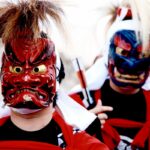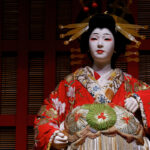It is believed that during the 17th century Kabuki first came about. It is a form of traditional Japanese theater that involves dance, song and elaborate choreography and costumes.

Even today, people are still enjoying Kabuki performances. However, one of the most intriguing things about Kabuki is how long a performance can be.
A Kabuki play has various lengths. It can last for four hours or more, or take as little as half an hour. To really appreciate Kabuki – and often how long they are – we shall explore the length of Kabuki.
We shall also take a look at what Kabuki is in more detail. So if you are interested, read on!
What Is A Kabuki Performance?
Kabuki is a traditional form of Japanese performance that is said to have begun in the 1600s. It uses emphasized movement by using unique choreography and vocalization for an overall dramatic delivery of a story.
Some of these stories are based on historical real-life happenings, while others twist tales of well-known mythical fantasies and the like.
During a Kabuki performance there is a lot of exaggeration when it comes to things such as the costumes, masks and makeup – the latter also being known as Kumadori.
The actors wear very elaborate outfits. They also use distinctive makeup techniques which is unlike any other type of theater performance.
The movements in Kabuki theater are often accompanied by music. This means you will find musicians on the stage playing the likes of flutes and drums.
An actor may move with the sound of the beat, which is often louder if the actor stamps their foot on the ground.
Kabuki has been in Japanese culture for many centuries. It has earned its place as a prestigious type of theater production.
How Did Kabuki Begin?
In 1605, a woman named Okuni was the first ever person to perform Kabuki. It is said that she was riding a horse and became inspired by her current emotions.
Her idea was to create something called Kabukiza, otherwise known as a ‘dance expressing emotions’. ‘Kabu’ is a word that is often referred to as meaning ‘frustration’ or ‘anger’.
The name makes a lot of sense during this time. Many people were wanting to feel free after spending a number of years enduring the civil wars and social changes (of the 15th and 16th centuries).
This type of dance would surely help people release the frustration they had been feeling. The Shogun era had begun, and change was in the air.
Are Women Allowed To Perform In Kabuki?
Women used to perform in Kabuki. Just like we said before, it was actually a woman who invented Kabuki. However, In 1629 women were banned from performing Kabuki. This was because of prostitution of the female actors.
There were also very violent fights among some of the patrons when it came to accepting favors off these female actresses.
Despite the ban, this did not stop any of the issues surrounding the problem. Young male actors were also pursued by some of the patrons.
Even though times have clearly changed, women are still not allowed to perform in Kabuki. Instead it is still an all-male cast.
Even the female characters are played by men. Obviously this is nothing new – Shakespeare also used to have men play female characters.
Do Kabuki Plays Have Acts?

Typically a Kabuki performance has around five different acts to a story. The first act, otherwise known as Jo, is often a very slow introduction. It then has enthralling battles and dramatic scenes in acts two, three, and four.
The final act is five which is where the story ends. However, these five acts are during full length performances. There may be shorter performances which do not have the full five acts.
When it comes to the five acts, the story is told in a specific way. The acts are structured in order for you to understand what is going on. This is just like other types of theater performance, however a Kabuki usually has a particular structure.
This does not mean that all of the stories are the same, however.
How Long Is A Kabuki Performance?
A Kabuki performance can last as long as five hours. However, there are breaks in between each act.
This means that you will not be sitting for the whole of the five hours. More often than not you will get at least 20 minutes to walk around and use the restroom.
Even so, a Kabuki theater performance may only last for 30 minutes. It all depends on the performance you have booked to see, and whether you were able to book a ticket for one act only.
How Can You Buy Tickets To Watch A Kabuki Performance?
If you would like to watch a whole Kabuki performance, then you will be able to buy your tickets for the performance online. However, if you would prefer to only see an act, then you will need to go to the venue to purchase tickets.
When it comes to the day of the performance, head to the theater. You are likely to pay around 2,000 yen to watch one act.
If you buy a ticket in advance for the whole performance, then you can expect to pay anywhere from 3,000 yen to 25,000 yen. However, this depends on which seats you go for.
There is no dress code to see a Kabuki performance, however it is best to go for a smart appearance. That means no sneakers!
Are Kabuki Actors Famous?
Japan views Kabuki actors as if they are famous movie stars. They hold Kabuki actors in very high regard. Because of this, many locals will return to see a production just to watch their favorite actor.
They may even shout out the actor’s stage name (also known as yago in Japanese).
A Kabuki actor having a stage name is seen as an honor within Japan. The name is passed down through the generations of a family who are all actors.
However, being given this stage name which has been passed down to them also puts a lot of pressure onto the actor. They will need to do just as well as the family member before them did.
To receive their stage name a ceremony known as Shumei takes place. It is often very elaborate and is done in front of an audience. It takes the actor into a new phase of their successful Kabuki performance career.
Final Thoughts
A Kabuki performance can take up to five hours long, or as little as half an hour. It often comes down to how you want to watch the Kabuki production. This is because you can buy a ticket to watch all of the acts, or just one of the acts.
Fortunately, there are breaks in between each act. This means you have the chance to go to the restroom or walk around between every Kabuki act.
Kabuki is a traditional art form that is still enjoyed today in Japan. It uses choreographed movements and vocals to create strong and exaggerated performances. It has been around since the 1600s, and is just as popular today as it was back then.
- 16 Best Websites To Watch Japanese Movies With English Subtitles - May 11, 2023
- Is ZIPAIR The Best Airline For Traveling To Japan? - May 11, 2023
- Ryu Murakami Vs Haruki Murakami – Which One Should You Read? - May 11, 2023








